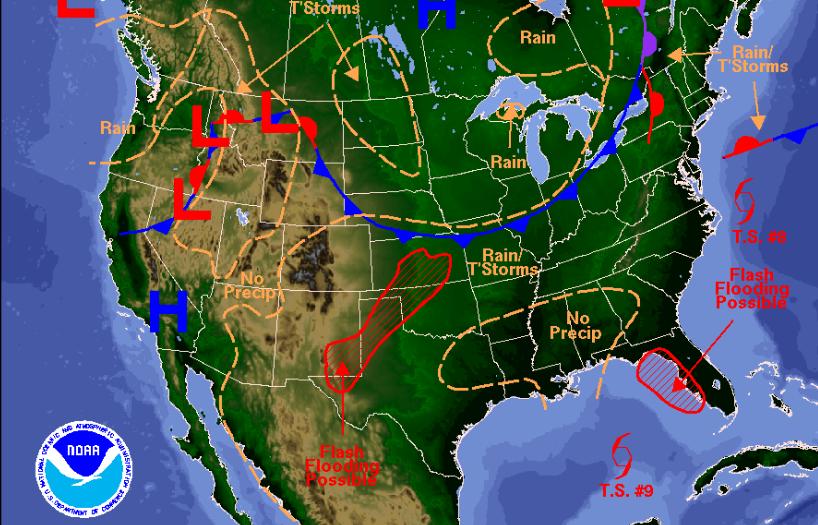
As the peak of hurricane season nears, there is potential for tropical storm conditions along the South Carolina coast on Friday. Forecasts are calling for heavy rain, which could cause coastal and flash flooding, and winds.
Forecasters predict the Lowcountry could feel an increased impact by Friday afternoon with winds reaching up to 70 miles per hour.
“We might see this thing get better organized in the Gulf and not lose too much as it moves across the land areas of south Georgia and South Carolina,” stated Live 5 Chief Meteorologist Bill Walsh.
There is also the chance for a small tornado threat in the Lowcountry on Friday as the tropical system passes nearby.

There is also the danger of deadly rip tides as the storm continues to track up the coast. The Red Cross is preparing to respond along the East Coast and urges people in the path of the storm to get ready too.
“With South Carolina being threatened by tropical weather, people should stay informed about weather conditions and get prepared now,” said Louise Welch Williams, regional chief executive officer for the American Red Cross.
The approaching storm is a reminder that the state is in the middle of hurricane season, which lasts until the end of November.
GET READY NOW It’s the best way to be prepared for these dangerous storms. People should:
- Build an emergency kit with a gallon of water per person, per day, non-perishable food, a flashlight, battery-powered radio, first aid kit, medications, supplies for an infant if applicable, a multi-purpose tool, personal hygiene items, copies of important papers, cell phone chargers, extra cash, blankets, maps of the area and emergency contact information. Many of these items are available through the Red Cross Store at org.
- Talk with household members and create an evacuation plan. Practicing the plan minimizes confusion and fear during the event. Plan routes to local shelters, register family members with special medical needs as required and make plans for pets.
- Be informed. Conditions can change quickly; listen to local weather advisories and stay informed about the storms through local media. Learn about your community’s hurricane response plan and use the South Carolina Hurricane Guide to “Know Your Zone” for evacuations. If you are told to evacuate, do so immediately. You may choose to evacuate sooner than alerted if you think you may need additional time.
People should also download the free Red Cross Emergency App to select up to 35 different severe weather and emergency alerts on their mobile device. The content includes expert guidance on what to do before, during and after different emergencies or disasters from home fires to hurricanes as well as locations of open shelters. All Red Cross apps can be found in smartphone app stores by searching for American Red Cross or by going to redcross.org/apps.
If someone already has a disaster kit, now is the time make sure the food and water is still okay to consume and that copies of important documents are up to date. If they already have an emergency plan for their household, they should talk about it again with family members so everyone knows what to do if an emergency occurs.
RIP CURRENTS With the storms churning in the Atlantic, there is an increased risk for rip currents. Rip currents are responsible for deaths on our nation’s beaches every year, and for most of the rescues performed by lifeguards. Rip currents can form in any large open water area, such as low spots and breaks in sandbars, or near structures such as jetties and piers. Swimmers should be aware of the following before swimming in waters that may have rip currents.
- If you are caught in a rip current, stay calm and don’t fight the current. Swim parallel to the shore until you are out of the current. Once you are free, turn and swim toward shore.
- Stay at least 100 feet away from piers and jetties. Permanent rip currents often exist near these structures.
- Check the conditions before entering the water. Look for any warning flags are up or ask a lifeguard about water conditions, beach conditions, or any potential hazards.
FLOODING People in South Carolina know all too well the devastation that floodwaters can cause. Keep your whole family safe with these tips.
- Stay away from floodwaters. If you come upon a flowing stream where water is above your ankles, stop, turn around and go another way. Six inches of swiftly moving water can sweep you off of your feet.
- If you come upon a flooded road while driving, turn around and go another way. If you are caught on a flooded road and waters are rising rapidly around you, get out of the car quickly and move to higher ground. Most cars can be swept away by less than two feet of moving water.
- Keep children out of the water. They are curious and often lack judgment about running water or contaminated water.
- Be especially cautious at night when it is harder to recognize flood danger.
- Because standard homeowner’s insurance doesn’t cover flooding, it’s important to have protection from the floods associated with hurricanes, tropical storms, heavy rains and other conditions that impact the U.S. For more flood safety tips and information on flood insurance, please visit the National Flood Insurance Program Web site at FloodSmart.gov.





















Recent Comments